The Banyan tree is one of the biggest type of tree in the world and the journey of the Banyan tree began in India as the species Ficus benghalensis. Traders would gather under these trees for shade while going about their daily tasks.
They are now the national tree of India. What started as just one type of tree, banyan now refers to the fig species Urostigma and 750 species of fig trees that exhibit the same growing behaviour.
It’s this behaviour that’s earned these trees the nickname strangler figs. That’s quite a hectic name for a tree so let’s take a closer look at how they operate.
More...
Family: | Moraceae |
|---|---|
Genus: | Ficus |
Species: | F. macrophylla |
Common name: | Moreton Bay fig or Australian banyan |
Sunlight: | Full sun to partial shade |
Soil: | Well-drained and slightly acidic |
Height: | Can reach heights of 60 metres |
Spread: | Up to 30 metres |
Maintenance level: | Low |
Introducing the Banyan Trees
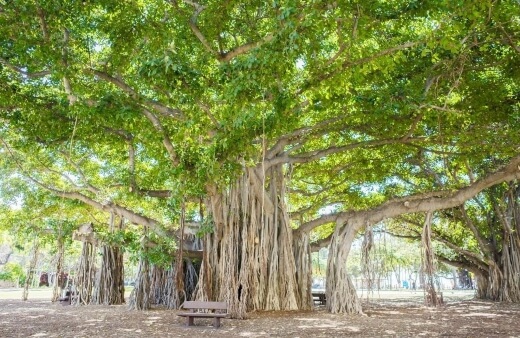
Banyans grow from seeds on other trees. They use their roots to overtake a host tree and it creates the effect of new tree trunks as the roots hang down towards the ground.
Banyan roots grow down from the branches into the ground. It’s quite a sight to see how long these branches are and this is what allows them to spread out and cover some serious ground.
The host tree essentially gets strangled by the banyan and eventually over time, the area that once held the original tree becomes hollow. The fruit of the banyan tree is home to fig wasps who help with the pollination process.
The banyan tree has some medicinal properties and has been used by the people of Nepal for ages to treat all sorts of ailments. They use the leaves, the bark and the roots.
The banyan tree might have started off in India but has travelled to other parts of the world like Florida, Hawaii and South Africa. Think tropical and subtropical when it comes to growing a banyan tree – they don’t handle the cold very well.
Types of Banyan Trees
Banyan Trees Around the World
Lahaina Banyan is found on the island of Maui and was planted in 1873. It is 12 metres tall with a canopy of 0.4 kilometres. The famous Great Banyan is over 250 years old and covers an area of 1.9 hectares.
It lives in a botanical garden near Kolkata in India. The whole garden is actually just one tree and it’s considered a world wonder. Thimmamma Marrimanu is the world’s largest tree canopy.
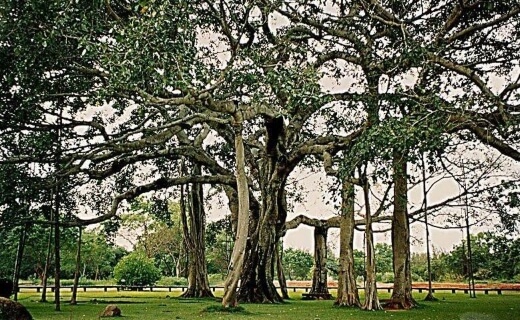
Source: en.wikipedia.org
This banyan tree was listed in the Guinness Book of World Records in 1989. It’s more than 550 years old, and covers an area of over 2 hectares. The tree circumference is a whopping 846 metres!
In South Africa, there are 2 banyan trees found in the Arderne Gardens in Cape Town and the Pretoria Zoo. They have the widest canopies of any tree in South Africa.
The Botanical Garden of the University of Coimbra in Portugal and public spaces in Sicily also boast some beautiful banyan trees worth noting.


Get Your Free Guide:
Master Growing Australian Natives eBook
A Must Have Complete Guide for Every Australian Garden
Get Your Free Guide:
Master Growing Australian Natives eBook
A Must Have Complete Guide for Every Australian Garden
Banyan Tree Species
Ficus microcarpaNative to Pakistan, Sri Lanka, China and Australia, to name just a few. They are actually considered invasive in certain areas. |  |
Central American banyan (Ficus pertusa)Native to central America and parts of South America. | 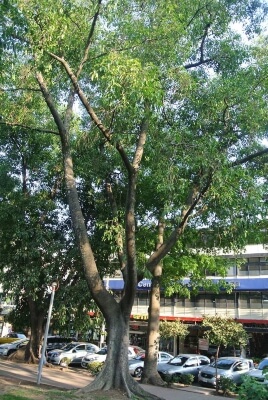 Source: guatemala.inaturalist.org |
Shortleaf fig (Ficus citrifolia)Native to southern Florida, Caribbean, and South America. |  Source: en.wikipedia.org |
Florida strangler fig (Ficus aurea)Also native to southern Florida and the Caribbean but it has thicker veins on its leaves than the shortleaf fig. | 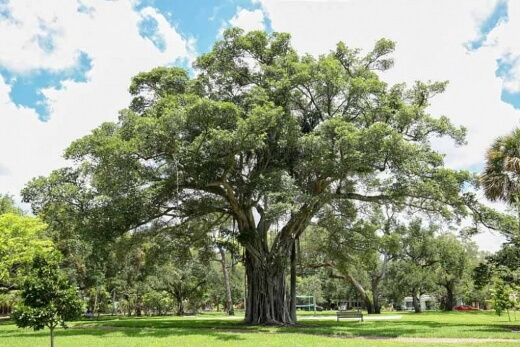 Source: gardenia.net |
Moreton Bay fig (Ficus macrophylla)We’ll chat about later in the article, and Port Jackson fig (Ficus rubiginosa). |  |
Ficus microcarpa

Native to Pakistan, Sri Lanka, China and Australia, to name just a few. They are actually considered invasive in certain areas.
Central American banyan (Ficus pertusa)

Source: guatemala.inaturalist.org
Native to central America and parts of South America.
Shortleaf fig (Ficus citrifolia)

Source: en.wikipedia.org
Native to southern Florida, Caribbean, and South America.
Florida strangler fig (Ficus aurea)

Source: gardenia.net
Also native to southern Florida and the Caribbean but it has thicker veins on its leaves than the shortleaf fig.
Moreton Bay fig (Ficus macrophylla)

We’ll chat about later in the article, and Port Jackson fig (Ficus rubiginosa).
How to Grow Moreton Bay Fig in Australia
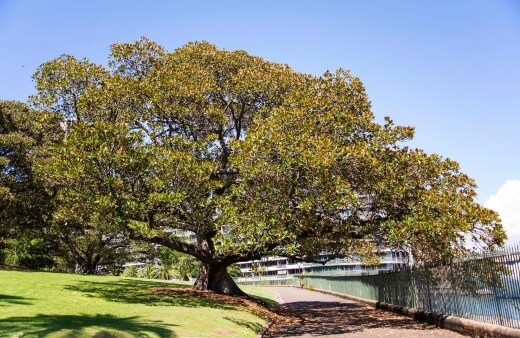
The Moreton Bay fig (Ficus macrophylla) is also known as the Australian Banyan. The name is a bit of a giveaway, which tells us that the tree is native to eastern Australia.
When thinking of the Banyan tree, we think it is huge but you might be surprised to know that you can actually grow Moreton Bay fig in a pot as a bush.
If you give it more space outdoors, you’re looking at a tree that will grow to a height of about 60 metres. This tree is a rainforest tree and has gigantic roots. If there is space to grow, it will use it!
What gives the tree the look of being a forest of sorts, is that the roots can spread out the same distance as the top of the tree. That means the roots are shallow but because they can spread quickly and over a great distance, it gives the tree strength and helps it to access nutrients.
The Moreton Bay fig has quite distinct leaves – they are long and large. The name of the species macrophylla is Greek – makros and phyllon mean “large leaf”. The tree fruits start out yellow and then become purple when ripe.
You can eat the fruit – it’s rather sweet but a bit dry. Not exactly a welcome snack it is not very palatable. Maybe leave it for the birds and the bats instead. Moreton Bay fig flowers are small and are produced inside the fruit. They are pollinated by small wasps.
Growing Moreton Bay Fig Outdoors
If you’re planning to grow a Moreton Bay fig as an outdoor tree, you’ll need lots of space. It’s not a usual choice for a garden in the suburbs as the roots can cause lots of damage.
If you have the space, you’ll be growing a tree that will offer a wonderful amount of shade. If you want to see some of the bigger trees that have earned themselves fame, you can visit the botanical gardens in Sydney, Brisbane and Melbourne.
The Moreton Bay fig is an investment tree – they can live for 150 years or more. They are quite adaptable when it comes to soil, but well-draining is always king.
Maximising sun exposure for the tree will see it thriving for years to come. For those living in coastal areas, the tree doesn’t mind the wind. A light frost is also not a problem.
How to Propagate Moreton Bay Fig
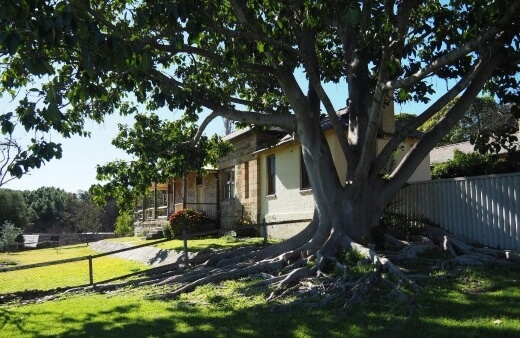
Propagating Ficus macrophylla from seed
You first need to source your seeds from a ripe fruit picked off a Moreton Bay fig. Just make sure the fruit isn’t green. Remove your seeds from the fruit and prepare a mixture of hydrogen peroxide (6%).
You’re going to shake your seeds around in the hydrogen peroxide mixture which actually sifts out any infertile seeds. After this process, you can plant the seeds in a potting mix and wait for them to germinate.
Once germination has taken place, you can move the seeds into individual pots with a moisture rich soil mix.
Moreton Bay Fig Propagation from Cuttings
The ideal time to take cuttings is at the end of the dormant season. Aim for a cutting from a branch that isn’t more than three years old and just under 2cm thickness is fine, with a cutting length around 30cm.
When you take the cutting, cut the bottom part flat and the tip part at an angle. Once you’ve got your cutting/s, you need to seal the angled end and dip the flat end in rooting hormone.
When you plant, place the flat end 15cm deep and give the cutting sufficient water. Always beware of overwatering. It will take about a year for the trees to be ready for transplanting and then you’re well on your way to enjoying lovely shade and some fruit (which is more for the garden wildlife than for you).
Caring for Moreton Bay Fig
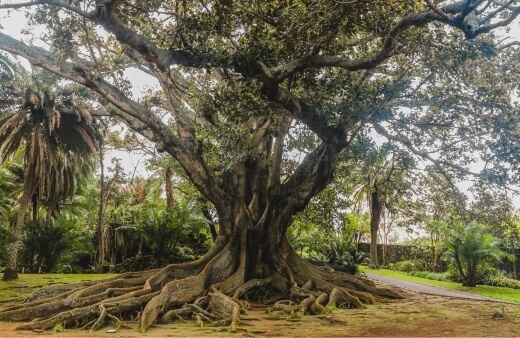
Climate
Moreton Bay fig likes warmth and humidity. It won’t handle cold or frost very well. The sweet spot for temperature is 20 to 30 degrees Celsius.
Sunlight Preference
Bright and indirect light is the order of the day. If you are growing your Moreton Bay fig inside, make sure it has shade otherwise the leaves might burn in summer.
In winter, you can up the sunlight quota which helps to brighten up the leaves. If the leaves start falling off, you know the tree doesn’t have enough sunlight.
Best Soil for Moreton Bay Fig
Think fertile when it comes to the soil. Lots of organic matter and good drainage is a must. A slightly acidic pH is perfect. If you plant your tree in a pot, you can add leaf mould and organic fertiliser to your mix.
Watering Schedule
Your Moreton Bay fig doesn’t need much water. If you’re looking after a potted tree, first check if the soil is dry. As a rule of thumb, you can water each week during the spring, summer and autumn seasons.
Watch out for water logging otherwise you could be dealing with root rot. The tree grows very quickly in summer – if the temperature is very high you can increase watering.
In the same way, you could probably water every 2 weeks during the winter. You can increase humidity by spraying if the air gets too dry.
What Fertiliser to Use
If your Moreton Bay fig is living outdoors you don’t need to fertilise too often – about 3 times a year is plenty. For the potted kind, you can fertilise every 2 weeks.
Aim for a lower concentration so you don’t burn the roots. Applying fertiliser in the evening helps absorption and you can reduce your frequency of fertilising in winter.
Pruning Ficus macrophylla
The Moreton Bay fig produces fruit the whole year, but is the most generous with its fruit in spring. That is your cue to start pruning, and you’ll start with the fruit.
You might want to do regular touch ups to help the tree grow healthy and lush leaves. It’s best to wait until the tree is a bit older before you start any regular pruning.
A little tip to help the tree bear more fruit, is to trim the branches that are quite close to the main branches. This process just allows space for better and more fruit bearing branches.
If you’re going to get pruning, you’ll need the right tools for the job. We’re passionate about in-depth and honest reviews of every kind of gardening product so don’t miss our gardening tool and equipment reviews.
Pests and Diseases that Affect Moreton Bay Fig
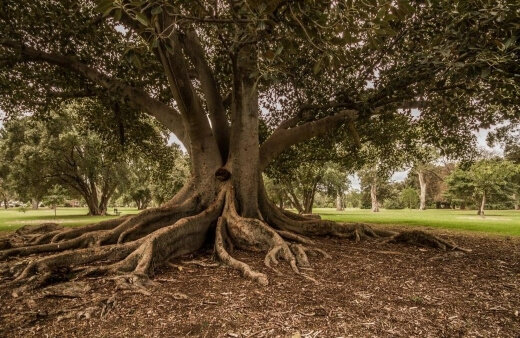
Your main concern to look out for with your Moreton Bay fig is root knot nematode that might take a liking to your tree. You’re looking for bumps on the roots which have whitish worms.
The leaves become yellow and might start to wither. It’s even possible for the plant to die if the infection is really bad. If there is hope of saving your tree, you can add large amounts of compost and organic matter to your soil.
This supercharges other microorganisms in the soil that will show the nematodes who’s in charge. A good way to minimise chances of root knot nematode is also keeping your weeds under control so the worms don’t feast on the weed roots. Our in-depth buying guide and product reviews on the best weed killers will help you on this task.
Trusty neem oil, which is great for managing and treating so many pests and diseases (and is kind to the environment), can actually help with the nematodes as well.
It actually stops the eggs from hatching and limits the number of root knot nematodes altogether. Neem oil also works for red spider mite, another pest that likes to show up on Moreton Bay fig trees.
Choosing a tree for your garden is a long term commitment and investment. Looking to add more trees to your collection? If you need info, inspiration, or a bit or both, have a look at our collection of tree growing guides.
Moreton Bay Fig Frequently Asked Questions
Where is the Moreton Bay fig considered an invasive species?
In New Zealand. The Moreton Bay fig grows large and strong here and also doesn’t have anything that threatens or limits its growth. This means it has the potential to overtake other native plants.
When did the Moreton Bay fig arrive in the USA?
This tree made its first appearance in the 1870s, arriving in California. The USA has some banyan trees worth noting. The tallest Moreton Bay fig in the USA is found next to the Natural History Museum in San Diego.
It was planted in 1914 and is 24 meters in height, spreading over an area of 37 meters. The widest tree is the Santa Barbara Moreton Bay fig. Planted in 1876, it spreads over an amazing 53 meters.
How quickly does a Moreton Bay fig grow?
The tree grows just under a meter per year.
How does the Moreton Bay fig pollinate?
Fig trees, including the Moreton Bay fig, actually pollinate themselves. With the help of the fig wasp, this tree does not require male and female species to pollinate.
It’s incredible to think that of all the different types of fig tree that exists, each species of wasp pollinates one specific species of fig. Each fig and wasp are perfectly matched by nature for the pollination process.

Wrapping up Our Banyan Tree Guide
If you want to see large Moreton Bay fig trees, you can plan a visit to the Brisbane, Melbourne and Sydney botanical gardens. Here you will find trees that were planted in the 19th century and an amazing 35 metres tall.
Banyan trees really are a natural marvel and wonder. Seeing a historic tree that has created a forest of its own, just with roots and a spreading canopy, will make you look twice to make sure you’re seeing correctly.
It’s incredible to think how Banyan trees and Moreton Bay fig thrive and survive. Nature really is amazing.
Published on July 19, 2022 by Nathan Schwartz
Last Updated on January 26, 2025





Hi Nathan,
There’s a Moreton Bay Fig on our street that we all love but in the last 2 years it’s become spindly with hardly any leaves on the tips. It’s on a rock face so drainage doesn’t appear to be a problem. A few years ago the council planted a kangaroo vine at its base which has totally invaded the tree and I feel is surely strangling it, but the council are adamant the vine is propping up the tree not strangling it. The vine is almost covering the entire old tree now. What do you think? It looks to me like it needs a good feed but I’m not sure how to help it. Was wondering about sprinkling some cow manure into the soil at the top of he cliff where the tree is growing, so the tree gets the nitrogen not the vine? Thoughts?
Hi Lalla,
Kangaroo vine is a tough plant, but the council are right – it won’t be causing any direct damage to the Moreton Bay Fig. However, like any large trees, shrubs and climbers planted together, they will be competing for nutrients, and the roots of kangaroo vines do tend to outcompete their neighbours.
I know from experience how heart-breaking it is when councils decide to remove mature trees – they add so much character to their space. So, yes, it’s definitely worth mulching around the base once a year to feed the tree and the vine together.
Cow manure can be pretty potent when it’s fresh, so if you decide to use manure, make sure it’s been rotted for about six months, and don’t let it touch the bark at the base.
Personally, I’d suggest something gentler like grass clippings or even pine needles, which will help to retain moisture, and make the soil slightly ericaceous (better for the fig, worse for the vine), while still adding the nitrogen that both plants need.
Best Regards,
Gary Clarke
I have a few Morton bay figs I’m new to the area and any all information has become very important to me
We hope our article provides you with everything you need. If you have any specific questions though, feel free to ask and we’ll be happy to help.
Best regards,
Gary Clarke